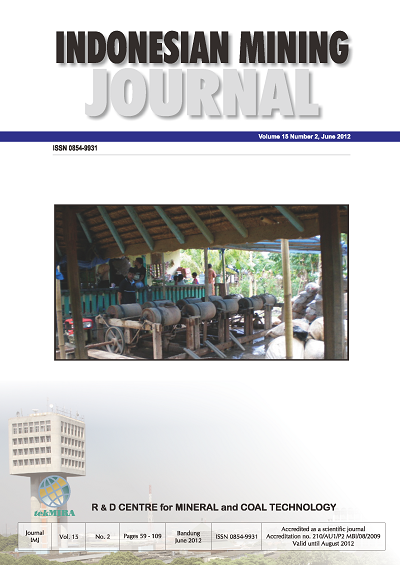SUSCEPTIBILITY TO SPONTANEOUS COMBUSTION OF SOME INDONESIAN COALS
DOI:
https://doi.org/10.30556/imj.Vol15.No2.2012.463Keywords:
Spontaneous combustion, moisture content, differential thermal analysis, crossing point temperatureAbstract
Eight Indonesian coal samples of different moisture contents obtained from the various coalfi elds were used to study spontaneous combustion characteristics by differential thermal analysis (DTA) and crossing point temperature (CPT). Results indicate that there is no direct correlation between the spontaneous combustion test data and the individual properties of the coal samples by both DTA and CPT test methods; in this study, a preliminary conclusion can be drawn on the coal moisture content effect on spontaneous combustion. Higher moisture content coals are more susceptible to spontaneous combustion than that of lower moisture content coals. It also can be stated that the susceptibility of coal to spontaneous combustion is basically a complex. Clearly more tests are required to investigate the effect of coal properties in more detail from other Indonesian coals that have various types and ranks.
References
Beamish, B.B. and Arisoy, A., 2008. Effect of min- eral matter on coal self-heating rate, Fuel 87, p. 125–130.
Blazek, C., 2001. The influence of moisture on the spontaneous combustion of coal, Benetech Report, Benetech Inc., Illinois.
Carpenter, A. M., 1999. Management of Coal Stockpile, IEA Coal Research.
Ejlali, A., Aminossadati, S.M., Hooman, K., and Beamish, B.B., 2009. A new criterion to design reactive coal stockpiles, International Communica- tions in Heat and Mass Transfer 36, p. 669–673
Fei, Y., Aziz, A.A., Nasir, S., Jackson, W.R., Marshall.
M. Hulston, J. and Chaffee A.L., 2009. The spon- taneous combustion behavior of some low rank coals and a range of dried products, Fuel 88, p. 1650–1655.
Kadioğlu, Y. and Varamaz, M., 2003, The effect of moisture content and air-drying on spontaneous combustion characteristics of two Turkish lignites, Fuel 82, p. 1685–1693.
Kaymakçi, E. and Didari, V., 2002. Relations between coal properties and spontaneous combustion pa- rameters, Turkish J. Eng. Env. Sci. 26, p. 59-64.
Kücük, A., Kadioğlu, Y., and Gülaboğlu, M. S., 2003. A study of spontaneous combustion characteristics of a Turkish lignite: particle size, moisture of coal, Humidity of Air, Combustion and Flame 133, p. 255-261.
Mahidin, T., Usui, H. Ishikawa, S. and Hamdani, 2002. The evaluation of spontaneous combustion char- acteristics and properties of raw and upgraded Indonesian low rank coals, Coal Preparation 22, p. 81-90.
Nugroho, Y. S., McIntosh, A. C. and Gibbs, B. M., 2000. Low-temperature oxidation of single and blended coals, Fuel 79, pp. 1951-1961.
Qi, X., Wang, D., Milke, J. A. and Zhong, X., 2011. Crossing point temperature of coal, Mining Science and Technology, 21-2, 2011, p. 255-260
Santoso, B. and Daulay, B., 2005. Type and rank of selected tertiary Kalimantan coals, Indonesian Mining Journal 8-02, p. 1-12.
Santoso, B. and Daulay, B., 2007. Comparative petrog- raphy of Ombilin and Bayah coals Related to their origin, Indonesian Mining Journal 10-09, p. 1-12.
Sensogut, C. and Cinar, I., 2006. A research on the spontaneous combustion tendency of Turkish coals-ilgin lignite’s case, Applied Science Research 1(1), p. 9-14.
Umar, D.F., Usui, H., and Daulay, B., 2005. Charac- terization of upgraded brown coal (UBC), Coal Preparation 25-1, p. 31-46.
Wang, H., Dlugogorski B.Z. and Kennedy E.M., 2003. Analysis of the mechanism of the low-temperature oxidation of coal, Combustion and Flame 134, p. 107–117.
Wang, D., Qi, X., Zhong, X. and Gu, J., 2009. Test method for the propensity of coal to spontaneous combustion, Procedia Earth and Planetary Science 1, p. 20–26.
Wang, D., Zhong, X., Gu, J. and Qi, X., 2010. Changes in active functional groups during low-temperature oxidation of coal, Mining Science and Technology 20, p. 0035–0040.
Watanabe, W.S. and Zhang, D. 2001. The effect of inherent and added inorganic matter on low-tem- perature oxidation reaction of coal, Fuel Processing Technology 74, p. 145–160.
Downloads
Issue
Section
License
Indonesian Mining Journal provides immediate open access to its content on the principle that making research freely available to the public to supports a greater global exchange of knowledge.

This work is licensed under a Creative Commons Attribution-NonCommercial 4.0 International License.













